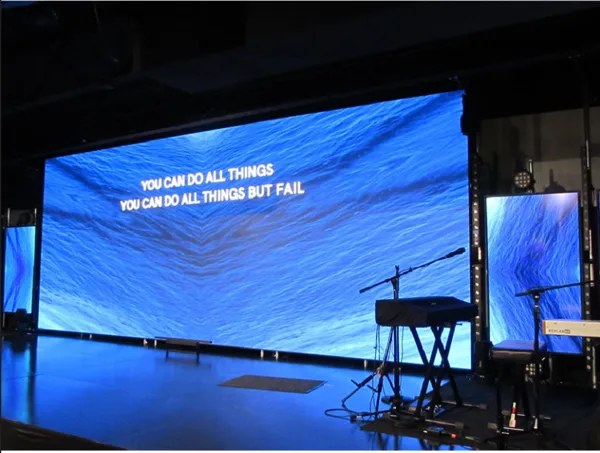
The best type of LED display screen?
With the innovation and advancement of LED technology, the types of LED displays are also constantly increasing. When purchasing an LED display, do you feel confused about which type to choose? Don’t worry, this article will help you understand which type of LED display is best.
Indoor and Outdoor Types
Indoor environments are stable with uniform lighting, making indoor LED display screens the optimal choice. Indoor LED display screens typically have a brightness level of approximately 800–1,500 nits, causing minimal disruption to the existing lighting conditions indoors.
Additionally, indoor LED display screens have undergone significant improvements in installation and maintenance, enabling quick setup and disassembly. Indoor LED displays are highly favored by many businesses due to their vibrant colors, realistic image quality, and diverse functionalities, and are widely used in indoor settings such as train stations, retail spaces, exhibitions, museums, and gyms.

In contrast, outdoor environments require consideration of factors such as rain proofing and wind/sand resistance to withstand harsh weather conditions. Therefore, the brightness level of LED displays must reach between 5,000 and 10,000 nits, with a waterproof rating of at least IP65 or higher, and specialized power supplies and cables must be used to ensure long-term outdoor use.
Outdoor LED displays serve as excellent tools for advertising, urban beautification, and event performances, particularly P6 outdoor LED displays, which are suitable for viewing from a distance and are commonly used in large stages or product launches.
The above are the differences between indoor and outdoor LED displays. You might think that outdoor LED displays are better than indoor ones, but that’s not the case. These two types of LED displays are designed with different performance specifications to meet specific environmental requirements, aiming for optimal display quality and environmental adaptability.
Therefore, both outdoor and indoor LED displays are equally exceptional; choosing the most suitable LED display based on your usage scenario and needs is the best approach.

After understanding the differences between indoor and outdoor LED displays, you need to clarify your specific requirements. If you require a temporary solution, renting an LED display is a viable option. If you require a permanent installation, a fixed-type LED display is more suitable. Let’s explore the differences between these two types:
Rental and Fixed-Type LED Displays
Rental LED displays and fixed-type LED displays are two categories within indoor and outdoor LED displays. Rental LED displays offer flexibility, cost-effectiveness, and the ability to be disassembled and reassembled repeatedly in various sizes. Rental LED displays are represented by LED cabinets, which are lightweight, space-saving, and easy to disassemble, making them ideal for short-term or frequently relocated events.
Rental LED displays are specifically used for various indoor and outdoor stage events, such as concerts, performances, galas, weddings, and other temporary setups requiring quick assembly and disassembly.

Fixed LED displays are the counterpart to rental LED displays, with the primary difference being that fixed LED displays are designed for long-term use in a single location. Compared to rental LED displays, fixed LED displays are not easily moved once installed, and their cabinet structures are heavier, serving to secure and waterproof the display.
Fixed LED displays come in various installation types, such as wall-mounted and column-mounted, and are suitable for locations like sports arenas, conference rooms, exhibition halls, and building facades. They are commonly used for broadcasting TV programs, advertising, conference support, and livestreaming.

Of course, there is no significant difference in display performance or image quality between rental LED displays and fixed LED displays. The choice depends on the event and venue requirements. If you need to set up temporary performance events and frequently change venues, renting an LED display is the optimal choice.
However, if you want to install an LED display in a stadium for broadcasting sports events, a fixed LED display is the optimal choice. Therefore, selecting an LED display that meets your specific needs can maximize economic benefits.
If you want to pursue a unique style beyond rental or fixed options, you can also consider creative LED displays that differ from traditional displays. Let’s take a closer look:
Creative and Traditional Types
Compared to traditional LED displays, creative LED displays not only feature design aesthetics and innovation but also possess exceptional flexibility, enabling the production of LED displays in various shapes according to specific requirements, such as circular LED displays, spherical LED displays, cylindrical LED displays, or other custom-designed LED displays.
Creative LED displays can enhance event atmospheres with their unique and innovative designs. They are commonly used in retail stores, exhibition halls to showcase products, or in commercial plazas and landmark buildings, where they attract attention, generate significant commercial value, and enhance event engagement.

While traditional LED displays may lack the innovation and interactivity of creative LED displays, they excel in video playback, advertising, corporate events, and entertainment applications. Of course, creative LED displays utilize more complex technology, resulting in higher costs compared to traditional LED displays.
The choice between the two depends on the desired event effect and budget requirements. If the goal is simply to enhance the atmosphere, increase interaction, and convey information, traditional LED displays are sufficient. However, if the aim is to significantly enhance the event atmosphere and make the event stand out, creative LED displays offer a clear advantage.
This is because creative LED displays feature innovative and entertaining display effects that can quickly capture attention and enhance audience engagement, providing an immersive viewing experience.
Conclusion
The above outlines the approach to selecting the optimal LED display type. Through this article’s guidance, we believe you will have a clear plan to ultimately choose the most suitable LED display.